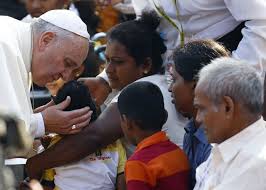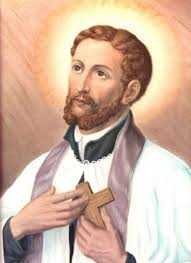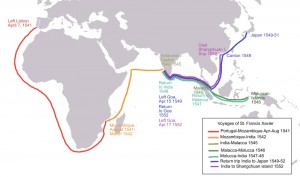We are called to preach and proclaim the Gospel “courageously and in every situation.” Pope Francis

When people speak of Pope Francis, they often refer to the pontiff as the “Pope of Firsts.” Jorge Mario Bergoglio, the Cardinal Archbishop from Argentina, is the first pontiff in the 2,000-year history of the Roman Catholic Church to be chosen from Latin America, the first Jesuit to be elected, and the first to take the name Francis. Judging from statements at the start of his pontificate, he is also the first pope since the early Church to emphasize evangelization—or MISSION—as the highest priority in the Church.
While every recent pope has noted that all Christians, by virtue of baptism, are called to Mission, they have presented evangelization as one of many church works, such as preserving orthodoxy in church teaching, increasing vocations and encouraging Sunday Mass attendance and confessions. While not denying the importance of these issues, Pope Francis sees them in the context of Mission. “May the whole of ministry be in a Missionary Key,” he says.
To serve others as Missionaries allows us to grow in our holiness as Missionary disciples. As Christians, we are challenged to give out hearts to God: to do something more, take action beyond ourselves and HELP someone else. Pope Francis teaches us that “by loving and helping the poor, we love and serve Christ.”
Below are Saints that we can look to as examples of holiness and evangelization. Click each name to learn more about these family members in Heaven.
Patron Saints
Venerable Archbishop Fulton Sheen

Archbishop Fulton Sheen, now “Venerable” was director of the Pontifical Mission Societies from 1950-1966.
In February of 1951, Venerable Archbishop Sheen, in a radio address inaugurated the World Mission Rosary. “We must pray, and not for ourselves, but for the world. To this end I have designed the World Mission Rosary.” Praying the Rosary, Archbishop Sheen said, would “aid the Holy Father and his Pontifical Mission Society for the Propagation of the Faith by supplying him with practical support, as well as prayers, for the poor Mission territories of the world.”
Learn How to pray the World Mission Rosary.
He clearly and effectively communicated the Catholic Church’s message and mission on the radio and television, as well as through his many writings. He presented the inspiring stories of the Missions and told of the love and joy of those serving the poor in those areas of the world. In 1951 Archbishop Fulton Sheen founded Mission Magazine. Today, more than 60 years after that inaugural issue – Mission Magazine continues to introduce readers to the Mission story.
“The poor missions of the world need the comfortable to supply roofs for their churches, medicine for their hospitals, and clothes for their backs, but the comfortable need the poor in order that they may have the blessing of God in their hearts, the charity of Christ in their souls, and the intercession of the poor who are the friends of God.” Archbishop Fulton Sheen, editorial, Mission Magazine, April-May 1951 inaugural issue.

Saint Francis Xavier
December 3 is the Feast Day of St. Francis Xavier, Patron for Missionaries.
on April 7, 1506, Francis Xavier was born in Xavier Castle, located near Sangüesa, in the kingdom of Navarre [part of present-day Spain]. He was a member of a noble family, and his childhood was one of privilege—however, it was disrupted by his father’s death, as well as by outside efforts to take control of Navarre.
In 1525, Xavier went to study at the University of Paris. There, he encountered Ignatius of Loyola, who had experienced a religious conversion while recovering from a war wound. Loyola did his utmost to convince Xavier to join him on the same path of devotion.
Though at first hesitant, Xavier was eventually inspired by his friend’s example. On August 15, 1534, in the Montmartre section of Paris, Xavier, Loyola and five others pledged themselves to the Society of Jesus [the Jesuits]. In addition to vows of celibacy and poverty, they also promised to visit the Holy Land.
Impressed by the Jesuits, King John III of Portugal asked the order for missionaries to work in his empire. Though Loyola initially selected others for the task, Xavier stepped in when a fellow priest became ill. He left Rome on March 15, 1540.

Xavier arrived in Goa, India, on May 6, 1542. He came to be admired in that country for his ability to live and work side by side with the poor. Seeking more converts, Xavier continued to travel; his stops included Ceylon, the Molucca Islands, the Banda Islands and the Malay Peninsula.
On August 15, 1549, Xavier landed at Kagoshima, Japan. As he had at his other missions, Xavier arranged for the translation of religious texts. These steps helped him reach more converts in the year and a half he spent in Japan.

Xavier’s next focus for missionary work was China. He traveled to Sancian (Shangchuan) Island, near Canton, but was not able to access the mainland because borders had been closed to foreigners. Before he could find a way inside the country, illness incapacitated Xavier. He died on the island on December 3, 1552, at the age of 46.
Though he passed away at a relatively young age, Xavier had accomplished much in his life. In addition to being a founding member of the Jesuit order—the Society of Jesus was officially recognized by Pope Paul III in 1540—he baptized an estimated 30,000 people. Xavier was beatified by Pope Paul V in 1619, and canonized by Pope Gregory XV in 1622.
A famed Missionary himself, he is now the Patron Saint of Missionaries.
Saint Therese of Lisieux

October 1 marks the Feast Day of St Thérèse of the Child Jesus and the Holy Face, Patroness of all Missionaries and the Missions, Patroness of France and Doctor of the Church.
“In spite of my littleness, I would like to enlighten souls as did the Prophets and the Doctors. I have the vocation of the Apostles. I would like to travel over the whole earth to preach your Name and to plant your glorious cross on infidel soil. But…one mission alone would not be sufficient for me, I would want to preach the Gospel on all the five continents simultaneously and even to the most remote isles. I would be a missionary, not for a few years only, but from the beginning of creation until the consummation of the ages.”
With these words Thérèse of Lisieux expressed her fervent wish to serve God as a missionary.
Her wish almost came true because her own convent in France was hoping to send some sisters out to a sister house in Saigon, and before her health failed Thérèse had been selected for the missionary enterprise. But by the age of twenty-four Thérèse was dead. Her life had been almost totally hidden. At her death she seemed just another obscure nun in a country convent in France. Most of the nuns didn’t recognize her great holiness. One said, “I cannot understand why people speak of Sister Thérèse as if she were a saint. She never does anything notable.” Thérèse had great ambitions to serve God, but at her death it looked like her life had come to nothing. Nevertheless, on her deathbed Thérèse said she believed God had granted all her desires.
Excerpts from Dwight Longenecker: St Thérèse of Lisieux – Model for Missionaries, The Story of a Soul, Autobiography of St Thérèse of Lisieux, The Hidden Face: St Thérèse of Lisieux
Saints in Alphabetical Order
